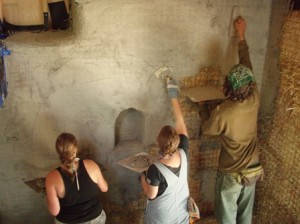
Question: Why should I use load bearing construction instead of post and beam infill?
Answer: It is a decision you will have to make on your own. Both options provide advantages and disadvantages when compared with each other. Load bearing is great for the owner builder and it is a bit less resource heavy. In truth, it comes down to personal preference. I have described the pros and cons of these types of construction in the past, so I won’t do it again here, but the fact remains that they are both amazing forms of construction that need to be considered strongly. Whichever you choose, you will have a beautiful and efficient home.
Question: Why aren’t rubble trench, rammed tires, or earth bag foundations appropriate for LB?
Answer: Those foundations can be appropriate for LB although it will take a lot more work for you to convince the building department of that. These foundation systems are considered alternative by almost every jurisdiction. That is not to say you should avoid them; however, you will need to KNOW YOUR STUFF when you present them to the building department. How will you anchor the bales to the foundation and the foundation to the Earth? How will loads be handled by such foundations? Can you back up your thoughts with data? I do not have the data for these questions as I tend to build traditional foundations on my homes. Don’t give up though. If you want to make it happen, you can.
Question: Are there any alternative methods for those who don’t wish to use the wire? Won’t the wire stretch/sag and pull away from the walls resulting in cracked plaster?
Answer: The wire will not sag and stretch as long as the bales have been properly pre-compressed. If the bales cannot compress further, the wire cannot sag. In addition, the plaster glues the mesh to the bales with a very strong mechanical bond. If you do not want to use the wire mesh, you can avoid it as long as you are not counting on it as your structural shear system and you are using a natural plaster. If you use a cement based plaster, you will be required to use some mesh reinforcement. Another option is to use plaster mesh in place of the wire.
Question: OK I’m going to come right out and say it. I’m terrified of roaches, rats, mice, snakes, and all sorts of creepy crawlies. So what about these critters and straw bale? Surely the straw becomes a nice place for them to live.
Answer: Actually, the straw is not a great place for any of these things to live for a number of reasons.
1. The straw is so dense that the critters cannot get a round in it.
2. There is no food source in the bales for any of these critters.
3. The plaster is so thick and hard that they cannot get into the straw to begin with.
4. There are much easier places for them to live that provide a lot more for them then the inside of your well detailed walls.
Question: I am a little concerned about the safety of a load bearing building because I live in an area prone to Tornadoes. Can you address that?
Answer: Straw bale walls are thick and durable. As long as they are anchored to the foundation properly, they will do well in high wind areas. Tornadoes tend to have a lot of risk and danger associated with flying projectiles. Those projectiles can puncture a conventional wall with ease, killing the occupants inside the home. I do not have any data showing that bale walls are any better, but I know that cement and thickness have an impact on the ability of a projectile to get through without being slowed down. My common sense suggests that a bale wall would be safer. I would love to see some one do some research on this and provide some data for us all.
Question: Is there a how-to video available for load-bearing?
Answer: Yes. It is included in our How-to Video Series. Learn more about it here.


